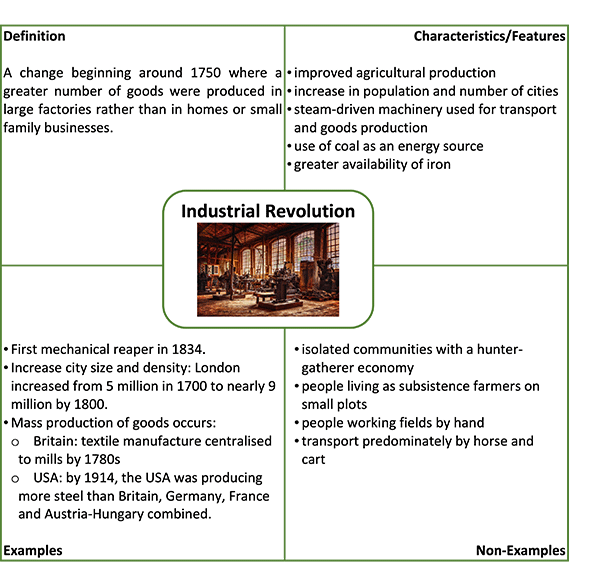Students must learn new terminology if they are to develop their understanding of historical concepts.
Historical language presents novel challenges for students. Students must understand
- discipline-specific terminology in contemporary texts
- how words are used and have meanings in primary sources (Downey & Long, 2015, p. 8).
This is particularly the case with written primary sources which reflect the writing conventions and conventions of time or socio-cultural context (e.g. the literary styles of Elizabethan English compared to Victorian English).
Word meanings may change over time. Words used in History texts and discourses may also require specific content knowledge to be understood. For example, democracy, slave, class, culture or revolution (e.g. French Revolution, Industrial Revolution, Agrarian Revolution) have different meanings in different historical and socio-cultural contexts (Taylor & Young, 2003).
Different types of historical language, with examples, are illustrated below.

(adapted from Taylor & Young, 2003, p. 16; Husbands 1996, p. 40)
Furthermore, there are several considerations to bear in mind when teaching historical terms and concepts:
- Some key terms that are used in history can be highly specific to a certain place, time or period
- for instance, 'The Blitz', 'The Reformation' and 'The Crusades'.
- Some key terms come from one period or context but can be applied to others
- Some key terms can be applied to many different contexts and might also have different meanings in different subjects.
- For example, the 'Industrial Revolution' is different from the 'Russian Revolution', and 'Church' can mean a place of worship or Medieval Catholicism.
Therefore, it is important to teach students the explicit meanings, examples and contexts in which these historical terms and concepts are used. Introducing new vocabulary enhances the ability of students to understand historical sources and accurately communicate historical understanding.
One-way teachers can do this is by using the Frayer Model. Other strategies for building vocabulary can be found in
the Science and
English sections of the toolkit.
Literacy in Practice Video: History - Understanding Historical Terms and Concepts
In this video, students are introduced to new vocabulary to enhance understanding of historical sources and support accurate communication of historical events in speaking and writing.
Read these in-depth notes for this video.
The Frayer model
The Frayer Model is a graphic organiser that supports students to identify and define unfamiliar historical terms and concepts. Its use in the classroom assists students to understand a term/concept more deeply (Biehl, 2001).
When using the Frayer model, students need to
- define a term/concept
- describe its essential features or characteristics
- provide examples of the term/concept
- non-examples of the term/concept.
An example of a completed Frayer Model chart on the Industrial Revolution created by a Level 9 or 10 student is shown (VCHHK129,
VCHHK130,
VCHHK131,
VCHHK132).

Ways to use the Frayer Model
- If there are several key terms/concepts for the lesson that are contained in the information source, teachers might allocate different terms/concepts for individual students or pairs to focus on.
- Teacher leads the class in a discussion of the definition quadrant of the model and together they jointly construct a definition of the focus historical event or period (for example, the industrial revolution, the black plague, or medieval Japan).
- Students work in pairs to discuss the information to be included in different quadrants.
- The teacher then asks the students to feedback the information they have included in each quadrant, and brings together a collated model on the board, or using a word document projected to the class.
- The completed model is then made available to students.
- Alternatively, students complete the Frayer Model in pairs for set terms such as the Industrial Revolution, and the teacher leads a class discussion about the similarities and differences between completed models for the same term.
- For example, one pair of students believe that something is a feature of the key term/concept, but another pair of students doesn't, so the teacher leads a class discussion to determine if the identified feature relates to the term.
- After a Frayer Model is completed, the teacher encourages students to include additional words or images to their Frayer Models based on further class discussion of each key term/concept.
- For example, images might be useful as a cue for students to recall key features or examples of the key term/concept (e.g. a picture of multiple factories for 'Industrial Revolution').
- Students use completed Frayer models as cue cards for key terms/concepts that they learn in History that they can refer to in preparation for future assessments.
- For example, students can cover over parts of their Frayer Model charts for different key terms/concepts (for example, hide the 'Characteristics/features' sections) to practise answering 'Describe' or 'Outline' questions that they might need to answer on a future assessment with the key term/concept.